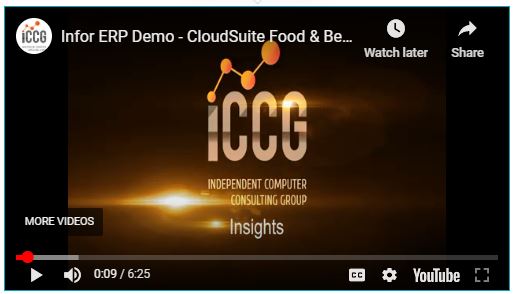Food and beverage companies face another pivotal year as the effects of the Covid-19 pandemic is forcing businesses to reevaluate their supply chain and operations strategy. To combat the challenges of supply chain disruption, shifting consumer demand, and market uncertainty, many organizations have turned to technology to promote resiliency and galvanize their business processes for the year ahead.
Below are five technology trends that experts anticipate will gain popularity in the years ahead as manufacturers prioritize agility and resilience over reactivity.
Read More
Topics: ERP, Food & Beverage, Supply Chain, Food Technology, CloudSuite Food & Beverage, Infor M3 ERP, Enterprise Software, WMS, Supply Chain Management
Adaptability and quick turnarounds on strategy had never been more vital during a challenging decade for the restaurants and food services industry so far. The good news for many is that so many organizations rose to that challenge, with restaurant technology playing a singular role in helping them to continue to meet demand and to serve guests via multiple channels, specifically using advanced restaurant point of sale and integrations with mobile ordering.
As much as the industry landscape has been defined by challenges and disruption, it’s also allowed decision makers to consider how present conditions help to anticipate what the rest of the decade might look like. This has meant looking at the basics, the essentials for successful restaurants to best consider and the continuing role restaurant technology will play. Over the last few weeks, we’ve published several posts that explore these factors. Here’s a summary to consider.
Read More
Topics: ERP, Food & Beverage, Distribution, Supply Chain, Supply Chain Visibility, digital disruption, Enterprise Resource Planning, Food Technology, CloudSuite Food & Beverage, Enterprise Software, Retail Supply Chain, Supply Chain Operations, Infor CloudSuite M3, Infor CloudSuite ERP
Throughout the pandemic, food and beverage companies have weathered surges in demand, rapid fluctuations in consumer buying habits, and the complexities of the global supply chain. Without complete enterprise-wide visibility or collaboration, shifting gears and adapting to trends in the market can seem insurmountable.
How can you modernize to keep pace with the speed of consumer needs in today’s competitive market? We recently did a webinar with Mark Winter, CFO of My Food Bag, to hear how his company, a leading online meal kit provider in New Zealand, managed to improve business productivity, efficiently manage the growth of its business and navigate the pressures of the pandemic.
Here are some valuable takeaways from the webinar. Watch the on-demand recording if you want to hear more about how My Food Bag deals with special requests from customers for particular food products, or ingredients, how the company manages last-mile delivery, and what they do to get the right balance between supply chain efficiency and sustainability.
Read More
Topics: ERP, Food & Beverage, Supply Chain, Food Technology, CloudSuite Food & Beverage, Infor M3 ERP, Enterprise Software, WMS, Supply Chain Management
Employees at hotel and other hospitality locations are the heart of their organisations, representing company values and mission to deliver the best possible guest experience consistently. But hospitality industry trends coming out of a very disruptive period show a worrying shortage of labour, with workers having time and financial support during lockdown to consider other options when it comes to their careers and their futures.
Making sure that hospitality work is rewarding, and that environments are supportive is more important than ever before to the future of the industry. How does advanced hotel technology help to address this vital concern? How must systems and processes in hotels and resorts best support hospitality workers day to day, help to identify how to reward their hard work, and retain their talent? Here are some examples to consider.
Read More
Topics: ERP, Fashion & Retail, Food & Beverage, Infor M3, Fashion & Apparel, Enterprise Resource Planning, CloudSuite Food & Beverage, Cloudsuite Fashion & Apparel, Infor M3 ERP
If you follow industry news, attend prospect events, or read our partner Infor's website, you know that vertical industry expertise is a favorite topic for Infor executives, leaders, and strategists. Industry-specific functionality is part of our critical foundation and a strong differentiating feature for our software solutions, we say frequently. But, have you thought about why? Do you know where our industry expertise comes from and how we leverage it into valuable selling points? Let’s look closer at what “industry expertise” means, why we are highly focused on it as a strategy, and how it will propel Infor forward.
The backstory
To understand where we are going, it helps to know how we got here. History provides context. In the evolution of ERP solutions, there’s a long and winding road that providers and users travelled before today’s Software as a Service (SAAS) model became the accepted best practice. In early days of ERP solutions, massive monolithic solutions with complex architecture and rigid code structure were the norm. Large enterprises invested heavily and hired consultants to customize the operational features. The heavily modified systems were costly to update.
Then came cloud computing. But, for companies to take advantage of the benefits of multi-tenant cloud deployment, they needed to have their industry-specific functionality already built into the solution—so modifications wouldn’t be needed. Modifications slow down deployment and can get in the way of upgrades.
Infor had been heavily investing into industry-specific features of the core ERP solutions. The solutions contain the functionality needed for industry specific applications—making it easier to migrate to the cloud.
Read More
Topics: ERP, Fashion & Retail, Food & Beverage, Infor M3, Fashion & Apparel, Enterprise Resource Planning, CloudSuite Food & Beverage, Cloudsuite Fashion & Apparel, Infor M3 ERP
When every transaction counts more so than ever before in restaurants and food services, forward-thinking strategies around restaurant menu management have become more important than ever before. Central to that is how much leading organizations have risen to the occasion to streamline the way they manage they their offering and push the newest versions of menus to the point of sale, unified across locations and concepts.
Restaurants and managed food services rely on current data and the technology needed to find useful narratives about how to enhance performance and maximize returns, specifically at the menu item level. How does that work? What role does restaurant POS play in that process? Let’s take a look.
Read More
Topics: ERP, Food & Beverage, Distribution, Supply Chain, Food Technology, CloudSuite Food & Beverage, Enterprise Software
Manufacturers in the food and beverage industry are increasingly turning to mergers and acquisitions to keep pace with consumer demands. In an era where speed is critical, many companies seem to find it to be faster and easier to form a partnership or make an acquisition, rather than invest in R&D or develop their own new products and brands from the ground-up.
The factors driving the trend
As economic recovery gains momentum and fuels a robust growth period in the food and beverage industry, expansion hungry manufacturers are eager to take advantage of new trends and the growing consumer obsession with the quality of the food they eat. Healthy snacks, plant proteins, clean labels, exotic taste experiences, neuro-nutrition, and socially mindful companies are all top-of-mind topics for today’s shoppers, especially millennials. Consumers now prioritize locally grown foods, sustainable farming, and organic and non-GMO foods, and are quite willing to read labels and research the origins of their meals, whether it be prepared in a four-star vegan restaurant or picked off the shelf of a corner convenience mart.
Read More
Topics: ERP, Food & Beverage, Supply Chain, Food Technology, CloudSuite Food & Beverage, Infor M3 ERP, Enterprise Software, WMS, Supply Chain Management
Food and beverage manufacturers rely on their R&D and marketing departments to develop new product ideas that capture market share before the competition can catch up. These departments leverage information available in their business systems to help them analyze trends ranging from buying patterns to cost fluctuations. The trouble is, when R&D and marketing rely on business systems that exist in silos— as is often the case with today’s food and beverage manufacturers opportunities are missed, product development is too slow, and costs creep higher. But when a manufacturer understands that every part of the organization has a stake in the product innovation process, and ensures that all the parts are connected, the organization is better positioned to deliver successful, innovative products quickly.
This white paper discusses a number of considerations that food and beverage manufacturers should make when examining ways to accelerate product innovation. This paper also details how digital technology can be the enabler of this acceleration.
Read More
Topics: ERP, Food & Beverage, Supply Chain, Food Technology, CloudSuite Food & Beverage, Infor M3 ERP, Enterprise Software, WMS, Supply Chain Management
Introduction
No food and beverage (F&B) company can afford unscheduled downtime. F&B is an industry pressured by outside forces such as consumer tastes and commodity pricing. But what is within control are the operations that get product to consumers. One big way to optimize production is to slash downtime to deliver tens of thousands of dollars back to the bottom line. In this e-book we provide tips on harnessing IoT, data-driven enterprise asset management (EAM), and smart technologies to strike a careful balance between lean efficiency and maximized uptime.
Read More
Topics: Food & Beverage, Distribution, Supply Chain, Food Technology, CloudSuite Food & Beverage, Enterprise Asset Management, Enterprise Software
Old, heavily modified ERP systems that were implemented years, often decades ago. can no longer support the complex demands of the food and beverage industry. Keeping current isn't just smart - it's profitable. From cloud computing and collaborative technologies to mobility and analytics, technology holds the key to competitive advantage and growth. To remain relevant to the market and responsive to customer expectations, you need a roadmap to enable digital transformation.
To understand why it's important to evolve and utilize modern technology to transform your business, it is helpful to discus the business drivers facing food and beverage manufacturers today. While many of the high-level issues may seem like the same challenges the industry has been fighting for years, the specifics have evolved -requiring you to take a fresh look at your business and core competencies in order to determine the best path for the future.
Cloud technology offers the only platform that can provide the speed, scalability, global reach, and agility required by businesses seeking to embrace innovation. To succeed, you need to reposition the cloud within your organization, making it the fundamental element of your competitive strategy and embrace new methods of technical operations. Below is the introduction to CloudSuite Food & Beverage introduction.
Read More
Topics: Food & Beverage, CloudSuite Food & Beverage








.jpg)


